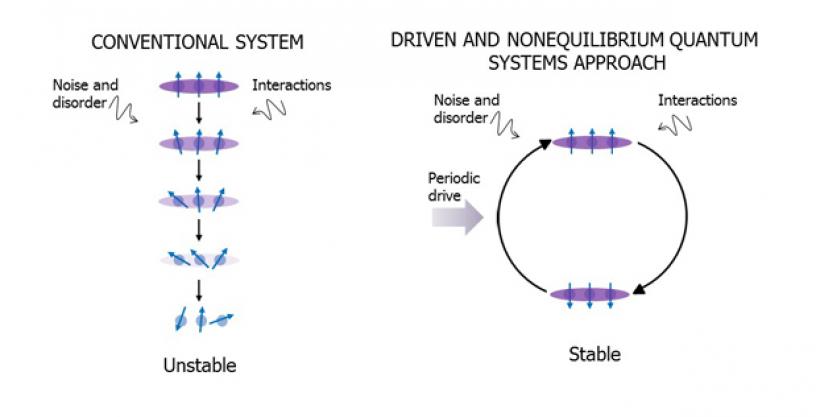
Agency unveils effort to yield 10- to 100-fold performance improvement for defense-related sensors and devices
Jan 18, 2018
Whether it is excited electrons emitting photons in a lightbulb or the vibrational frequency of atoms in an atomic clock, quantum phenomena are simultaneously fundamental aspects of nature and the basis of current state-of-the-art and future technologies. This is particularly the case as sensor and device performance continue to improve and approach their fundamental limits. It is not lost on DARPA that controlling quantum phenomena is an increasingly important challenge in the realm of national defense. High-precision atomic clocks can enable timekeeping for navigation and communications with GPS-like performance even in GPS-denied environments. And computing based on quantum bits, or qubits, which can represent a one, a zero, or a coherent linear combination of one and zero, could open routes to new kinds of computation. But there’s a hitch. The performance and reliability of quantum sensors and devices is dependent on the length of time the underlying quantum states can remain coherent. If you wait long enough, interactions with the environment will make the state behave like a conventional classical system. In many cases, this time is significantly short. DARPA, with an eye on practical quantum devices and sensors in compact sizes, has set its sight on demonstrating protocols that can dramatically extend the longevity of the coherence of quantum systems.
DARPA’s Defense Sciences Office (DSO) today announced a new fundamental research program, Driven and Nonequilibrium Quantum Systems (DRINQS) to investigate a recent paradigm shift in quantum research, which maintains that periodically driving a system out of equilibrium may stabilize its coherence.
“A simple illustration of the concept of driving something out of equilibrium to increase its stability is the well-known trick of making an inverted broom stand up on the palm of your hand or on one of your fingertips,” said Ale Lukaszew, DARPA program manager. “If you hold your hand still, the broom is unstable and will fall over quickly. But if you drive the broom out of equilibrium by moving your hand around periodically, you can make the broom very stable, so it remains upright indefinitely.”
States of quantum coherence are relatively short-lived because quantum particles are extremely sensitive to their surroundings and quickly become unstable, losing their predictable and readily measurable quantum properties due to even the slightest thermal variation or other disturbance in the environment.
“Atoms and subatomic particles in a quantum state do not always get along well with other particles and currently need special isolated environments where no thermal, electromagnetic, or other disturbance will cause them to lose their coherence,” Lukaszew said. “That’s why the world’s best atomic clocks for precision timing, which DARPA is pioneering in other programs, require special laboratory environments for isolating individual atoms from each other. This involves slowing atoms down by cooling them to near absolute zero temperature and creating with lasers a lattice structure in which the chilled atoms can rest quietly, unperturbed by their neighbors like eggs in a carton.”
“If we can introduce a periodic drive to enable particles to be packaged close together in small spaces at room temperature, while still retaining quantum coherence, we may be able to reproduce the performance of the best sensors, such as atomic clocks and magnetometers, in small and robust devices for military use,” Lukaszew said.
The new program will build collaborative teams of theoreticians and experimentalists to address novel approaches for driving quantum systems made up of large numbers of particles. The teams will be tasked to develop novel protocols for stabilizing coherence in a driven system and demonstrate proof-of-principle concepts that achieve at least 10-fold, and possibly 100-fold, improvement over the standard limits of quantum coherence.
“One exciting potential application for extremely precise atomic-based time measurements is measuring gravitational fields, which could be very useful in tunnel and cave detection,” Lukaszew said. “In principle, existing atomic-clocks can keep time precisely enough to measure gravitational field differences over the distance of a few feet, but it could take weeks to process the measurement. If we can engineer a system that doesn’t lose its coherence as fast and can be re-tuned very quickly, we could potentially make those same measurements in half an hour.”
A webinar Proposers Day outlining the objectives of the Driven and Nonequilibrium Quantum Systems program in more technical detail will be held on February 1, 2018. A special notice with registration information is available here: https://go.usa.gov/xnv6V. Pre-registration is required. A Broad Agency Announcement (BAA) solicitation is anticipated to be available prior to the webinar and will be posted on the DARPA opportunities page of the FedBizOpps website: https://go.usa.gov/xnpQU/
Image Caption: In a typical quantum system (left) the combined effect of interactions, noise, and disorder leads to its coherence (denoted by the combined direction of the arrows) disappearing after a short period of time. The Driven and Nonequilibrium Quantum Systems approach (right) aims to stabilize the quantum system in the presence of the same disturbances by adding a periodic drive.
# # #
Media with inquiries should contact DARPA Public Affairs at outreach@darpa.mil
Associated images posted on www.darpa.mil and video posted at www.youtube.com/darpatv may be reused according to the terms of the DARPA User Agreement, available here: http://go.usa.gov/cuTXR.
Tweet @darpa
